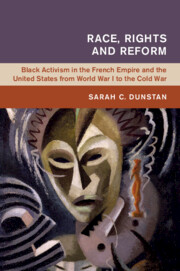 Race, Rights and Reform
Race, Rights and Reform Published online by Cambridge University Press: 01 March 2021
Chapter 3 maps out the different ways in which black activists from both the United States and France employed culture as a method of demonstrating their contributions to Western modernity and as a means of thinking through the relationship between republicanism and race. It spans from the 1925 publication of Alain Locke’s ethnographic anthology, The New Negro, through to the establishment of the anti-reformist, revolutionary journal Légitime Défense in 1932. During this period, understandings of race were framed by France’s vogue nègre of les années folles and the American negrophilia of the roaring twenties. These two phenomena had in common a fetishized representation of black men and women in the literature and anthropology of both nations. Many black thinkers such as James Weldon Johnson embraced this enthusiasm, reasoning that attention to the race and opportunities for patronage would eventually lead to greater social equality, an evolution that would theoretically enforce equality before the law. Other commentators and activists such as Jane Nardal and Alain Locke instead advocated a more inclusive understanding of what it meant to be civilized and to be human. These debates played out through journals that are rarely studied in tandem, such as Challenge, La Revue du Monde Noir, Opportunity and La Dépêche Africaine, as well as through the publications and personal correspondence of intellectuals such as Paulette and Jane Nardal, Alain Locke, Clara Shepard and René Ménil.
To save this book to your Kindle, first ensure [email protected] is added to your Approved Personal Document E-mail List under your Personal Document Settings on the Manage Your Content and Devices page of your Amazon account. Then enter the ‘name’ part of your Kindle email address below. Find out more about saving to your Kindle.
Note you can select to save to either the @free.kindle.com or @kindle.com variations. ‘@free.kindle.com’ emails are free but can only be saved to your device when it is connected to wi-fi. ‘@kindle.com’ emails can be delivered even when you are not connected to wi-fi, but note that service fees apply.
Find out more about the Kindle Personal Document Service.
To save content items to your account, please confirm that you agree to abide by our usage policies. If this is the first time you use this feature, you will be asked to authorise Cambridge Core to connect with your account. Find out more about saving content to Dropbox.
To save content items to your account, please confirm that you agree to abide by our usage policies. If this is the first time you use this feature, you will be asked to authorise Cambridge Core to connect with your account. Find out more about saving content to Google Drive.